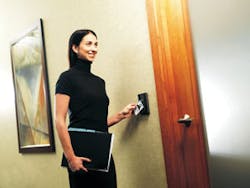We're an industry in transition. Every business is moving to mobile applications, remote solutions and wireless connectivity. For wireless in access control and intrusion detection, better range, reliability, stability, security and battery life are all part of the value proposition. And let's not forget the cost savings of wireless versus hardwired.
The lines are blurring in this product category as they are across the security landscape. So what constitutes access control? In the commercial protected premises it can be any number of different types of card, proximity and biometric readers, turnstiles, video/analytics, sensors and other intelligence to control entrance and egress. In residential, intrusion sensors and the new video and 'connected' systems are now parts of the access control fold as well. And that market, thanks to Web-based and hosted solutions, is finding new ways to entice the customer-with convenience they crave, coupled with security, energy management and other controls.
"The lines have blurred," said Sean Leonard, portfolio marketing director for Ingersoll Rand Security Technologies, Carmel, Ind. "We look at and define access control as the total opening," he said. "Communication over cell phones is really starting to open application opportunities," Leonard added.
Souped up Wi-Fi; Z-Wave grows
In late September the Federal Communications Commission (FCC) announced it was ironing out new spectrum rules that would result in a 'souped-up' version of Wi-Fi offering increased network capacity, signal strength, range, speed and the ability to penetrate walls. Signals would be able to travel several miles with speeds ranging from 15 to 20 Mbps.
Like Wi-Fi and Wi-Max, other wireless technologies are contributing to growth. Z-Wave has become the defacto standard in wireless communications in the home, according to Mary Miller, director of Marketing for the Z-Wave Alliance(tm), Milpitas, Calif. "Interoperability is the core brand value of Z-Wave products," Miller said.
Two types of wireless access control technologies are used most often in commercial premises, 2.4 GHz and 900 MHz signaling products. A 900 MHz communication product operates on 10 channels, from 902 to 928 MHz. With 2.4 GHz/802.11 Wi-Fi, communication goes from the lock to a Wi-Fi antenna and onto a network.
"Wi-Fi and Wi-Max are emerging strong but there may be some challenges with those in traditional commercial deployments concerning signal strength," Leonard said. "It's tougher for Wi-Fi to penetrate with its lower frequency, whereas 900 MHz works well in dense environments."
LOOK FOR ENCRYPTION
Encryption is not a problem with either 2.4 MHz or 900 MHz wireless system and both use the de facto encryption, AES 128-bit key. However, not all wireless systems provide it. Integrators should double check this is the encryption being used in the wireless systems they install.
Protection One Extends Its Reach with Wireless
"Handheld devices like iPhones, iPads and BlackBerries are the way the world is working and communicating. It's important that the security industry keeps step with this true convergence of technology. Internet video is one way tech-savvy business people and homeowners are using their handheld device to receive information from their electronic security system. For example, eSecure from Protection One allows customers to access their system keypad through their phones and view video surveillance of their home or business from an encrypted network. Latchkey parents are able to see their kids come home safely from school or keep an eye on pets. A business manager can check on employees at the office or view customer service activity through live streaming video.
Mark, a Protection One customer for more than 10 years, uses the sophisticated but user-friendly technology to connect with his family and keep an eye on his home in the country. As a frequent traveler and business owner, Mark said: 'while away, eSecure alerts me when someone has entered my home and I can turn the camera on using my iPhone to see who is in the entryway.' Mark's business, a 24-hour call center in Topeka, Kan., also has eSecure and video monitoring services and he said he has acquired clients specifically because of this technology and the ability of Mark's business to provide WAV files demonstrating his team's responsive to incoming calls. Technology is allowing unparalleled functionality and flexibility in security systems. Security 'apps' like eSecure will become an ever-increasing download for business and consumers alike."-Lisa Ciapetta, senior director of Marketing, Protection One, Wichita, Kan.
